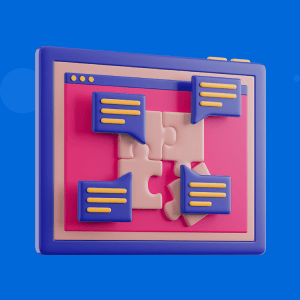Interpersonal learning
Table of Contents
The days of a one-size-fits-all approach to learning are over.
These days, instructional designers, teachers, coaches, and trainers have found much more success by adapting their material to the different learning styles of the people they are instructing.
In this guide, we’ll be going over the interpersonal learning style.
You’ll discover:
- What interpersonal learning is
- 7 important characteristics of interpersonal learners
- 3 activity ideas that work well for social learners
- Tips on how to create an interpersonal learning program
Now, let’s get right into it!
What is interpersonal learning?
Interpersonal learning is a kind of learning style. Interpersonal learners, also known as social learners, learn best through interaction and communication with others.
They are extroverts, vocal, and typically natural leaders.
Interpersonal learning links to interpersonal intelligence, one of the nine types of intelligence described by Howard Gardner in his Theory of Multiple Intelligences.
These are the intelligence types according to Gardner:
- Verbal-linguistic: Excellent verbal skills and sensitivity to sound, meaning, and rhythm of words
- Logical-mathematical: Conceptual and abstract thinking
- Spatial-visual: Thinking in images and pictures
- Bodily-kinesthetic: Body control and ability to manipulate objects skillfully
- Musical-auditory: Produce and appreciate music
- Interpersonal: Capacity to detect and respond to the mental states of others
- Intrapersonal: Self-awareness and reflexivity
- Naturalist: Recognition of plants and other objects in nature
- Existentialist: Thinking about the “deep questions” of meaning and purpose
It is important to note that the link between types of intelligence and types of learning is somewhat under dispute in professional literature.
Nevertheless, Gardner’s work provides a useful guide to learning experience designers on how to make their material more approachable to the largest number of people.
People can take in material better when it matches their learning style.
A visual learner will learn better when there are a lot of visual aids, and so on.
In the next section, we go over the seven characteristics of interpersonal learners.
7 characteristics of an interpersonal learner
Most interpersonal learners are social butterflies. They like to be around big groups of people, are good at understanding others, and are natural leaders.
Not that they are perfect.
Social learners might not perform the best when asked to work on solo projects.
And teachers, instructors, and coaches need to be ready to curb some negative behaviors of social learners: Socialization instead of studying or arguing with others too much over differences of opinion.
Characteristic #1: They’re collaborative
Interpersonal learners do very well in groups of people. They learn well in groups too.
This is why collaborative learning is such a great strategy for this type of learner.
A group project is probably a social learner’s favorite activity. They can put their skills to use: Collaboration with others, discussion, and debate, as well as an opportunity to be a leader.
For this reason, having an interpersonal learner in your learning group might benefit everyone. They learn best by helping others with the material.
Characteristic #2: They have strong communication skills
As they thrive in social situations, interpersonal learners have robust communication skills.
They can intuitively understand the opinions and preferences of other people.
Another way to put it is that social learners are very good at “reading” people.
As such, they take to group discussions and debates like fish to water.
Any learning experience that features a lot of interactive group work will suit social learners very well.
However, their need for communication and interaction might make them less inclined toward asynchronous learning.
Characteristic #3: They’re sociable
We’ve said it before, and we just have to say it again: Interpersonal learners thrive in social settings.
They like to be around people, and engaging in social activities energizes and motivates them.
This means they typically get along well with others and integrate happily into any group.
Any learning process involving lots of group activities will help these learners excel.
Characteristic #4: They have leadership skills
Because they’re good at reading others, social learners can navigate social interactions with ease.
This translates into keen leadership ability.
An interpersonal learner will quickly take charge of any group project and begin leading others.
Because they are so good at interpreting tone, gesture, and emotion, social learners use this to their advantage.
In group settings, instructors and coaches might need to reign this tendency in and not let interpersonal learners dominate every conversation.
Characteristic #5: They’re active
Unlike a linguistic or intrapersonal learner who may prefer less dynamic modes of learning such as reading and independent study, interpersonal learners need activity.
Interaction and discussion are key. Engaging in an activity is what motivates social learners the most.
They need a lot less time for quiet reflection on the study material and more engagement in an activity such as a study group where they can “think out loud” by talking to others.
Characteristic #6: They’re extroverts
This should come as no shock: You will rarely find an introvert among social learners.
Those with an interpersonal learning style have no trouble making friends.
They are the proverbial life of the party and any other social gatherings.
As such, they are very suited to synchronous learning events where there are a lot of chances to be social and interact with other people.
Characteristic #7: They’re vocal
Another characteristic to be aware of is that interpersonal learners are not afraid to speak up and for people to hear them.
If they don’t understand something, they’ll let you know. The same is true if they have an idea to make something better.
Social learners are anything but shy and timid. This is often a bonus for those conducting a learning experience as there will be a lot of feedback from people who have an interpersonal learning style.
In the next section of this guide, we look at which learning activities work well for interpersonal learning.
3 interpersonal learning activities to try
The basic premise of the theory of learning styles is that certain learning activities fit some learners better.
So, here are three great activities for engaging social learners and improving their learning outcomes.
Activity #1: Group projects
Groupwork is the bread and butter of any social learning program aimed at interpersonal learners.
Group work fits the natural inclinations of social learners very well. As part of a group project, they get to interact with others in ways they find stimulating.
It’s also a chance for them to display their natural leadership skills. Any group work requires the navigation of a complex social landscape—who does what, who makes the decisions?
While all that puts some people off (we’re looking at you, introverts), social learners find it enjoyable.
Conversely, they do not perform very well when asked to do individual projects. Working on their own lacks the social dynamics necessary for interpersonal learning to take place.
Group projects can take many forms. Presentations, case studies, prototypes—it doesn’t matter as long as there is a lot of social interaction and collaboration while doing it.
Using a learning management system (LMS), such as Docebo, can help keep track of group projects.
L&D teams can create channels for employees to share materials and collaborate on projects. When the project is complete, employees can upload the finished version directly in the LMS for instructors to evaluate and share feedback.
Activity #2: Discussions & debates
Given their highly developed communication skills, it’s no wonder that social learners love taking part in discussions and debates.
They are vocal and active, so arguing about things is in their nature.
These two collective learning activities are a chance for their interpersonal skills to truly shine.
Group discussions and debates display all the characteristics we mentioned above.
During conversational activities, they get to talk and listen and work through the content of the learning experience by interacting with others in the group.
This is why discussion and debate are a must if you have social learners in your training or study group.
Give them the chance to both ask and answer questions and to vocalize their own opinions about the subject matter they are learning.
An LMS, like Docebo, is a great way to encourage interpersonal learning in a large organization with a dispersed workforce. Learners can use Docebo’s social learning features to discuss training topics, share ideas, and ask in-company experts questions directly on the platform.
Plus, Docebo integrates with a number of video conferencing platforms so you can schedule, host, and track online debates and workshops within the LMS.
Activity #3: Peer tutoring
Studies have shown that peer tutoring has many benefits.
Among them are:
- An opportunity to interact directly with each other
- The tutors reinforce what they have learned as they instruct others
- Peer tutors improve their communication and interpersonal skills
These general benefits of peer tutoring also apply to interpersonal learners.
They love interacting with others. They absorb the material better when they tell people about it. And, they enjoy improving their interpersonal skills.
Using peer tutoring as a teaching method is a win-win for the whole training group. For instance, create opportunities for trainees to give peer-to-peer feedback, explain topics to each other, and solve problems together.
Consider complementing your training session or e-learning course with a role-playing exercise. These work equally well as an in-person training activity or in a virtual classroom.
A high-powered LMS like Docebo presents a number of opportunities for peer-to-peer learning.
For instance, employees can upload tutorial videos, how-to guides, recorded training workshops, and other learning materials to share their knowledge with their peers.
This promotes interpersonal learning and encourages knowledge sharing in the business. Plus, encouraging employee-generated training content takes some of the workload off us poor L&D teams. Phew!
Next, we give you tips on creating an effective interpersonal learning program.
Tips to create a successful interpersonal learning program
Interpersonal learning is a great learning method that allows people to use their senses in the learning process.
What’s more, learners tend to prefer direct involvement with others in group projects rather than isolating self-study.
Interpersonal learners are especially stimulated by dialog with others. A properly designed learning program is a bonus for both the social learners and the group as a whole.
Here are some tips on how to create a successful interpersonal learning program.
- Try to form as big a group as you can: The more the merrier is the rule with social learners. More people equals more activity and interaction. That means more opportunities for interpersonal learners to put their skills to use.
- Encourage your learners to work in teams: Take any chance to split your learners into groups and assign them tasks, no matter how small. Breakout rooms are a great way to achieve this in online sessions. This is interpersonal learning at its best because it promotes collaboration and interaction.
- Require course participants to give presentations: Social learners love to present what they know to others. Delivering a presentation lets them take on the role of the instructor for a little while.
- Include role-playing in the course plan: Interpersonal learners are good at understanding the viewpoints of others. Participating in role-playing lets them apply theory to real-world situations.
- Make use of peer teaching: Have your learners review each other’s work and have them take over the teacher role briefly.
- Have your learners organize an activity themselves: As an example, ask your learners to plan a small class party on the last day of the program. Deciding what and how to do it will give them a lot of informal interaction. It’s a great way to humanize your workforce.
- If you can, include field trips: Or do something as close to a field trip as you can in your context, such as offsites or online workshops. If you’re holding sales training separate from the “bullpen,” consider devoting some time to having your trainees observe and experience the real thing.
In the last part of our guide, we’ll recap everything we have learned so far.
Now over to you
It’s very important to do learning and development right and knowing about learning styles is paramount to designing your learning experiences.
Interpersonal learning is a type of learning style, but it can also be a principle for learning design.
Social learning promotes interaction, collaboration, discussion, and the forming of real human connections.
These are all things that can ultimately help in achieving positive learning outcomes.
Using an LMS is a great way to manage learning programs and foster interpersonal learning in your organization. To learn more about LMSs and other types of learning, visit our glossary.
Thanks for reading!

















